Western conifer seed bug
The western conifer seed bug (Leptoglossus occidentalis), sometimes abbreviated as WCSB, is a species of true bug (Hemiptera) in the family Coreidae. It is native to North America west of the Rocky Mountains (California to British Columbia, east to Idaho and Nevada) but has in recent times expanded its range to eastern North America, to include Nova Scotia, Maine, Connecticut, and New Hampshire,[1] and has become an accidental introduced species in parts of Europe.
| Western conifer seed bug | |
|---|---|
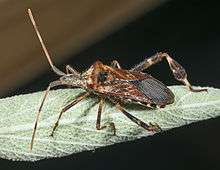 | |
| Scientific classification | |
| Kingdom: | Animalia |
| Phylum: | Arthropoda |
| Class: | Insecta |
| Order: | Hemiptera |
| Family: | Coreidae |
| Genus: | Leptoglossus |
| Species: | L. occidentalis |
| Binomial name | |
| Leptoglossus occidentalis Heidemann, 1910 | |
This species is a member of the insect family Coreidae, or leaf-footed bugs, which also includes the similar Leptoglossus phyllopus and Acanthocephala femorata, both known as the "Florida leaf-footed bug". Western conifer seed bugs are sometimes colloquially called stink bugs. While they do use a foul-smelling spray as a defense, they are not classified in the stink bug family Pentatomidae. In Chile, it has been confused with kissing bugs (Triatominae), causing unjustified alarm.[2]
Description
The average length is 16-20 millimeters, with males being smaller than females. They are able to fly, making a buzzing noise when airborne. Western conifer seed bugs are somewhat similar in appearance to the wheel bug (Arilus cristatus) and other Reduviidae (assassin bugs). These, being Cimicomorpha, are not very closely related to leaf-footed bugs as Heteroptera go; though both have a proboscis, but only the assassin bugs bite even if unprovoked, and L. occidentalis like its closest relatives can be most easily recognized by the expanded hindleg tibiae and by the alternating light and dark bands which run along the outer wing edges on the flaring sides of the abdomen. Their primary defense is to spray a bitter, offending smell; however, if handled roughly they will stab with their proboscis, though they are hardly able to cause injury to humans as it is adapted only to suck plant sap and not, as in the assassin bugs, to inject poison.
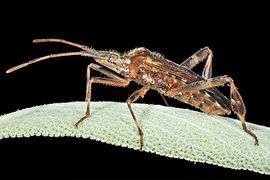 Profile
Profile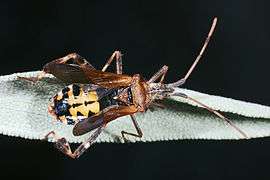 Abdomen
Abdomen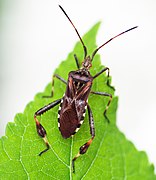 Back
Back- Detail of the head
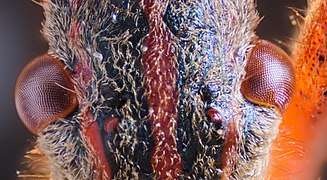 Macro photography of the eyes
Macro photography of the eyes
Ecology
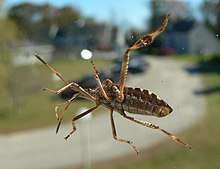
In its native range, the Western Conifer Seed Bug feeds on the sap of developing conifer cones throughout its life, and its sap-sucking causes the developing seeds to wither and misdevelop. It is therefore considered a minor tree pest in North America, but becoming sometimes more harmful e.g. in conifer plantations.[3] However, it is not monophagous and even adaptable enough to feed on angiosperms if it has to, though it seems to prefer resiniferous plants that are rich in terpenes. As these are produced by plants to deter herbivores, it might be that in evolving its ability to overcome these defenses, L. occidentalis actually became somewhat dependent on such compounds.
Its host plants in the native range include conifers like the Lodgepole Pine (Pinus contorta), the White Spruce (P. glauca), and the Coast and Rocky Mountain Douglas-firs (Pseudotsuga menziesii). Outside the native range, it is also found on species like the Eastern White Pine (P. strobus) and Red Pine (P. resinosa) in eastern North America and Europe, and the Mountain Pine (P. mugo), European Black Pine (P. nigra), Scots Pine (P. sylvestris) and Pistachio (Pistacia vera) (pistaches or pistacio trees) in Europe.[3]
The eggs are laid in small groups on the needles or leaf stems of its host plants, and hatch in spring. The nymphs go through 5 instar stages before moulting into adults. In the United States, the species is univoltine, but in southern Europe, it completes two generations a year, and in tropical Mexico even three. In the northern parts of its range, these bugs start to move about widely by September or so to seek crevices for overwintering; they may become a nuisance in areas with extensive conifer woods, as they will sometimes enter houses in considerable numbers.[3] They have the potential to become structural pests, as it has been found that they will sometimes pierce PEX tubing with their mouthparts, resulting in leakage.[4]
Range and invasiveness
This insect is common in its native range along the temperate and warmer regions of the Pacific coast of North America and has steadily expanded eastwards. On its native continent, L. occidentalis has been located as far northeast as Nova Scotia.[5]
In Europe, this species was first reported in 1999 from northern Italy; it had probably been accidentally imported with timber and, as it seems, more than once, as its presence was subsequently reported from that country almost simultaneously from locations a considerable distance apart. By 2007, it had established itself in the northern Balkans (Slovenia and Croatia), the Alps (Austria, Switzerland), and parts of the Czech Republic, France, Germany and Hungary; in 2003, it was found to occur in Spain, though this population probably derives from a separate introduction. The 2007 records from Weymouth College (England) and Oostende (Belgium) might also represent one or two further independent introductions. In late 2007, it was found at Wrocław and Miechów (Poland); these animals probably represent a further range expansion out of the Czech Republic.[3] During the autumn of 2008, a large influx of this species arrived on the south coast of England, indicating natural immigration from continental Europe.[6] In late 2009, a large group of western conifer seed bugs invaded Koç University in Istanbul, Turkey. The same thing happened in October 2012 in most of the cities of the French Alps, like Moûtiers. In 2017 it appears for the first time in the Southern Hemisphere, with several records from Chile.[7]
It was also first recorded from Tokyo, Japan in 2008,[8] and some additional records from Tokyo and Kanagawa Prefecture have been added until 2009.
References
- This article draws heavily on the corresponding article in the Italian-language Wikipedia.
- "Bug off! N.H. sees invasion of western conifer seed bug | New Hampshire" (PDF). UnionLeader.com. Archived from the original on March 4, 2016. Retrieved 2018-04-01.
- Faúndez, Eduardo I; Carvajal, Mariom A; Villablanca, Javier (5 August 2019). "Alien Invasion: The Case of the Western Conifer-Seed Bug (Heteroptera: Coreidae) in Chile, Overreaction, and Misidentifications". Journal of Medical Entomology. 57 (1): 297–303. doi:10.1093/jme/tjz127. PMID 31380562.
- Jerzy A. Lis; Barbara Lis & Jerzy Gubernator (2008). "Will the invasive western conifer seed bug Leptoglossus occidentalis Heidemann (Hemiptera: Heteroptera: Coreidae) seize all of Europe?" (PDF). Zootaxa. 1740: 66–68. doi:10.11646/zootaxa.1740.1.8.
- Bates, S.L. 2005. Damage to common plumbing materials caused by overwintering Leptoglossus occidentalis (Hemiptera: Coreidae). Canadian Entomologist 137: 492-496.[journals.cambridge.org/article_S0008347X00002807]
- Eric R. Eaton & Kenn Kaufmann (2006). Kaufman Field Guide to Insects of North America. Houghton Mifflin. ISBN 0-618-15310-1.
- Chris Malumphy; Joseph Botting; Tristan Bantock & Sharon Reid (2008). "Influx of Leptoglossus occidentalis Heidemann (Coreidae) in England". Het News. 12: 7–9.
- Faúndez, Eduardo; Rocca, Javiera; Villablanca, Javier (2017). "Detection of the invasive western conifer seed bug Leptoglossus occidentalis Heidemann, 1910 (Heteroptera: Coreidae: Coreinae) in Chile". Arquivos Entomolóxicos. 17: 317–320. Retrieved 2019-08-06.
- Tadashi Ishikawa & Yusaku Kikuhara (2009). "Leptoglossus occidentalis Heidemann (Hemiptera: Coreidae), a presumable recent invader to Japan". Japanese Journal of Entomology. new series. 12 (3): 115–116.
External links
| Wikispecies has information related to Leptoglossus occidentalis |
| Wikimedia Commons has media related to Leptoglossus occidentalis. |